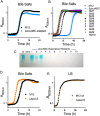Bile Salts Regulate Zinc Uptake and Capsule Synthesis in a Mastitis-Associated Extraintestinal Pathogenic Escherichia coli Strain
- PMID: 34228495
- PMCID: PMC8445175
- DOI: 10.1128/IAI.00357-21
Bile Salts Regulate Zinc Uptake and Capsule Synthesis in a Mastitis-Associated Extraintestinal Pathogenic Escherichia coli Strain
Abstract
Extraintestinal pathogenic Escherichia coli (ExPEC) strains are major causes of urinary and bloodstream infections. ExPEC reservoirs are not completely understood. Some mastitis-associated E. coli (MAEC) strains carry genes associated with ExPEC virulence, including metal scavenging, immune avoidance, and host attachment functions. In this study, we investigated the role of the high-affinity zinc uptake (znuABC) system in the MAEC strain M12. Elimination of znuABC moderately decreased fitness during mouse mammary gland infections. The ΔznuABC mutant strain exhibited an unexpected growth delay in the presence of bile salts, which was alleviated by the addition of excess zinc. We isolated suppressor mutants with improved growth in bile salts, several of which no longer produced the K96 capsule made by strain M12. The addition of bile salts also reduced capsule production by strain M12 and ExPEC strain CP9, suggesting that capsule synthesis may be detrimental when bile salts are present. To better understand the role of the capsule, we compared the virulence of mastitis strain M12 with that of its unencapsulated ΔkpsCS mutant in two models of ExPEC disease. The wild-type strain successfully colonized mouse bladders and kidneys and was highly virulent in intraperitoneal infections. Conversely, the ΔkpsCS mutant was unable to colonize kidneys and was unable to cause sepsis. These results demonstrate that some MAEC strains may be capable of causing human ExPEC illness. The virulence of strain M12 in these infections is dependent on its capsule. However, capsule may interfere with zinc homeostasis in the presence of bile salts while in the digestive tract.
Keywords: ExPEC; ZnuABC; bile salts; group III capsule; mastitis-associated E. coli; zinc transport.
Figures





Similar articles
-
Genome-Wide Identification of Fitness Factors in Mastitis-Associated Escherichia coli.Appl Environ Microbiol. 2018 Jan 2;84(2):e02190-17. doi: 10.1128/AEM.02190-17. Print 2018 Jan 15. Appl Environ Microbiol. 2018. PMID: 29101196 Free PMC article.
-
Context-Dependent Requirements for FimH and Other Canonical Virulence Factors in Gut Colonization by Extraintestinal Pathogenic Escherichia coli.Infect Immun. 2018 Feb 20;86(3):e00746-17. doi: 10.1128/IAI.00746-17. Print 2018 Mar. Infect Immun. 2018. PMID: 29311232 Free PMC article.
-
Human extraintestinal pathogenic Escherichia coli strains differ in prevalence of virulence factors, phylogroups, and bacteriocin determinants.BMC Microbiol. 2016 Sep 20;16:218. doi: 10.1186/s12866-016-0835-z. BMC Microbiol. 2016. PMID: 27646192 Free PMC article.
-
Secreted proteases: A new insight in the pathogenesis of extraintestinal pathogenic Escherichia coli.Int J Med Microbiol. 2019 May-Jun;309(3-4):159-168. doi: 10.1016/j.ijmm.2019.03.002. Epub 2019 Mar 22. Int J Med Microbiol. 2019. PMID: 30940425 Review.
-
Distinguishing Pathovars from Nonpathovars: Escherichia coli.Microbiol Spectr. 2020 Dec;8(4):10.1128/microbiolspec.ame-0014-2020. doi: 10.1128/microbiolspec.AME-0014-2020. Microbiol Spectr. 2020. PMID: 33385193 Free PMC article. Review.
Cited by
-
Poly-Gamma-Glutamic Acid Secretion Protects Bacillus subtilis from Zinc and Copper Intoxication.Microbiol Spectr. 2022 Apr 27;10(2):e0132921. doi: 10.1128/spectrum.01329-21. Epub 2022 Mar 21. Microbiol Spectr. 2022. PMID: 35311566 Free PMC article.
-
Modulation of TDM-induced granuloma pathology by human lactoferrin: a persistent effect in mice.Biometals. 2023 Jun;36(3):603-615. doi: 10.1007/s10534-022-00434-0. Epub 2022 Aug 17. Biometals. 2023. PMID: 35976499
-
Distribution of CRISPR in Escherichia coli Isolated from Bulk Tank Milk and Its Potential Relationship with Virulence.Animals (Basel). 2022 Feb 17;12(4):503. doi: 10.3390/ani12040503. Animals (Basel). 2022. PMID: 35203211 Free PMC article.
-
Genes associated with fitness and disease severity in the pan-genome of mastitis-associated Escherichia coli.Front Microbiol. 2024 Aug 29;15:1452007. doi: 10.3389/fmicb.2024.1452007. eCollection 2024. Front Microbiol. 2024. PMID: 39268542 Free PMC article.
References
Publication types
MeSH terms
Substances
Grants and funding
LinkOut - more resources
Full Text Sources
Medical

